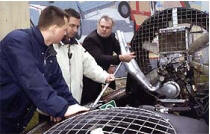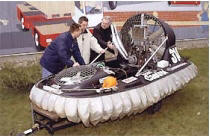The
timing belt that learned to Hover.
ATP
10 used in hovercraft racing
 It
weighs only slightly more than 180 kg, has two engines, two
propellers and looks like a boat that can fly. Wherever its builder,
Ingo Blank, from Hanover, appears, there is great excitement. This
unusual vehicle is a hovercraft, a mixture of floating boat and
tearing soapbox from England, the bigger version of which we got to
know from car advertisements and excursions across the Channel. It
weighs only slightly more than 180 kg, has two engines, two
propellers and looks like a boat that can fly. Wherever its builder,
Ingo Blank, from Hanover, appears, there is great excitement. This
unusual vehicle is a hovercraft, a mixture of floating boat and
tearing soapbox from England, the bigger version of which we got to
know from car advertisements and excursions across the Channel.
Ingo Blank, 32 years old and a fully-qualified car mechanic with
commercial training, is one of the few Germans to use a hovercraft
for sport in Germany, and he has been quite successful at the
international level of this sport which offers more than a hint of
originality, professional ability, courage and something
extraordinary and where big-name sponsors have yet to show any signs
of marketing interest. The type of work carried out by Blank at
Hanover-based forklift specialists Nicolic is stamped with
individualism, constant fiddling about and adjusting as well as
having the courage to continuously try and compete time and again at
the Formula 2 races in Germany, even after 6 years in the sport.
After all, this young man has already been second in this
second-highest hovercraft race series, which restricts the total
displacement of the engines used to 500cm3.
 It
was more than ten years ago that the man from Hanover came into
contact with this unusual sport, which also makes great demands on
mechanical ability as well as technical know-how, when an uncle
brought back a hovercraft from England, where they enjoy great
popularity. It
was more than ten years ago that the man from Hanover came into
contact with this unusual sport, which also makes great demands on
mechanical ability as well as technical know-how, when an uncle
brought back a hovercraft from England, where they enjoy great
popularity.
Together with his father, who also still races, the Blanks enjoyed
their hovercraft so much that Ingo started to build his own
hovercraft. The hovercraft bug had got hold of him and has not left
him to this day.
As fast as he is during the week-end training sessions and during
the six 20-minute races, Ingo Blank nevertheless has an almost human
problem: he constantly has to be aware of weight, not only his own,
but also every ounce of his racing machine, which floats on its air
cushion at almost 100 km/h over the course and which the pilot
controls by means of weight transfer and two guide blades located in
the airflow of the rear propeller. Every ounce which does not have
to be moved has a positive impact on the performance.
 It
was this application and the wish for even better weight
distribution which, with the close co-operation of Jürgen Dittrich
of MULCO EWIV partner Wilhelm H. Müller, Hanover, led to the
introduction of a 32 ATP10 timing belt from the extensive product
range of MULCO EWIV, European market leader for polyurethane timing
belts. After all, the rear one of the two water-cooled two-stroke
engines, a 350 cm³ Yamaha engine, delivers approx. 60 horse power to
the propeller, whose rotor blades rotate at 3500 RPM when under full
load to speed the tips at more than 500 km/h. The pusher engine
generates 20 m³/sec. at the propeller, while the front 125 cm³
Suzuki two-stroke engine lifts the hovercraft 2.2 m³ every second. It
was this application and the wish for even better weight
distribution which, with the close co-operation of Jürgen Dittrich
of MULCO EWIV partner Wilhelm H. Müller, Hanover, led to the
introduction of a 32 ATP10 timing belt from the extensive product
range of MULCO EWIV, European market leader for polyurethane timing
belts. After all, the rear one of the two water-cooled two-stroke
engines, a 350 cm³ Yamaha engine, delivers approx. 60 horse power to
the propeller, whose rotor blades rotate at 3500 RPM when under full
load to speed the tips at more than 500 km/h. The pusher engine
generates 20 m³/sec. at the propeller, while the front 125 cm³
Suzuki two-stroke engine lifts the hovercraft 2.2 m³ every second. |